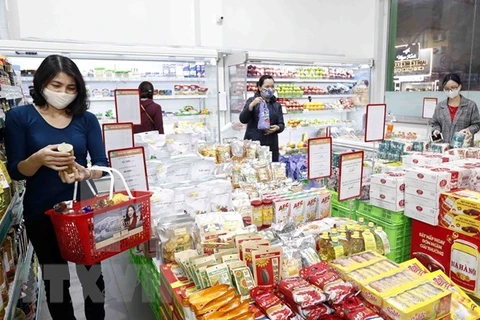Hanoi (VNA) - The Consumer Price Index (CPI) in January posted a year-on-year rise of 1.94 percent and inched up by 0.19 percent compared to the previous month, the General Statistics Office (GSO) reported on January 29.
It was also the last month of the lunar year, seeing an upward trend in prices of necessities and consumer services before Tet (Lunar New Year), the largest and longest festival of the Vietnamese people.
In addition, hikes in petrol prices in tandem with global fuel prices are attributed to the increase.
Photo: Nine out of 11 groups of goods and services experienced rising prices in January (Photo: VietnamPlus)
Nine groups of goods, services experience rising prices
A report from the GSO showed that nine out of 11 main groups of consumer goods and services experienced price rises. Just one recorded decreasing prices.
Among seven groups of commodities and services experiencing rising prices last month, transport witnessed the highest year-on-year increase, rising by 14.55 percent.
Housing and construction materials expanded by 3.51 percent because of higher prices of home repair materials; beverages and tobacco rose 2.75 percent.
Prices of textile products, footwear and clothes; household equipment and appliances; and medicine and health services saw marginal rises.
Meanwhile, education posted a decline of 3.78 percent against the same period last year, as tuition fees were exempt or reduced in some centrally-run localities. Post and telecommunications decreased by 0.65 percent.
The price of food and catering service groups remained stable. Food and catering services rose by 0.08 percent and 0.18 percent, respectively. Meanwhile, the foodstuff group inched down by 0.09 percent.
The price of rice in January increased by 0.04 percent year-on-year (up 0.09 percent in urban areas, and 0.01 percent in rural areas)
Nguyen Thu Oanh, Director of the Price Statistics Department under GSO, attributed the slight increase in the price of rice to the high export prices, plus the growing demand for high-quality rice and sticky rice during the Lunar New Year.
Regarding the reason behind the slightly decreased price of the food group, Oanh said China's tightening of COVID-19 prevention and control at some border gates caused congestion for Vietnam’s agricultural products.
The price of fresh, dried and processed vegetables in the domestic market fell by 6.05 percent compared to the previous month, she noted.
Besides decreased-price items, there were some commodities recorded rising prices such as pork (up 1.79 percent), contributing 0.06 percentage points to the CPI.
Gold prices, exchange rate move in opposite directions
Regarding the exchange rate, Oanh said the price f US dollar on the world market fell, as the US’s inflation in December 2021 increased by 7 percent over the same period last year. As of January 25, 2022, the US Dollar Index in the international market hit 95.68 points, down 0.52 points from the previous month.
The price of US dollar in the domestic market in January saw decreases of 0.32 percent in January, and 0.73 percent compared to the same period last year.
On the contrary, domestic gold prices rose by 1.08 percent over the previous month.
According to the GSO, the average gold price in the world market was up 1.46 percent compared to December 2021, standing at 1,819 USD/ounce, due to the decrease in US dollar price and bond yields. Investors are also worried that prices will continue to rise, and geopolitical tensions in Eastern Europe make safe assets like gold rise.
In the domestic market, the increasing demand for gold before the Lunar New Year festival caused the gold price index in January to climb by 1.08 percent compared to December last year, Oanh said.
The GSO said core inflation in January increased 0.26 percent from the previous month and was up 0.66 percent compared to a year ago.
The lower increase in core inflation than average CPI reflected fluctuations in consumer prices mainly due to rising prices of food, gasoline, oil and gas, Oanh said./.

























